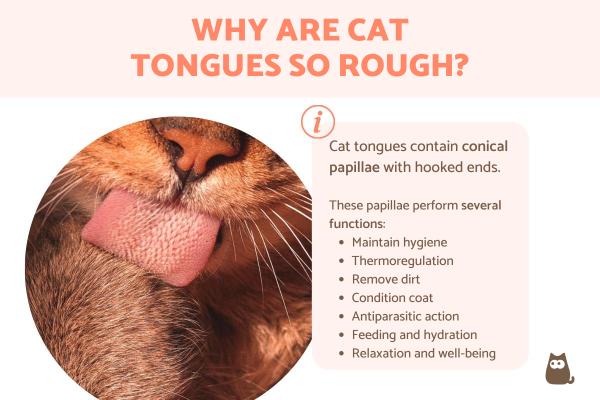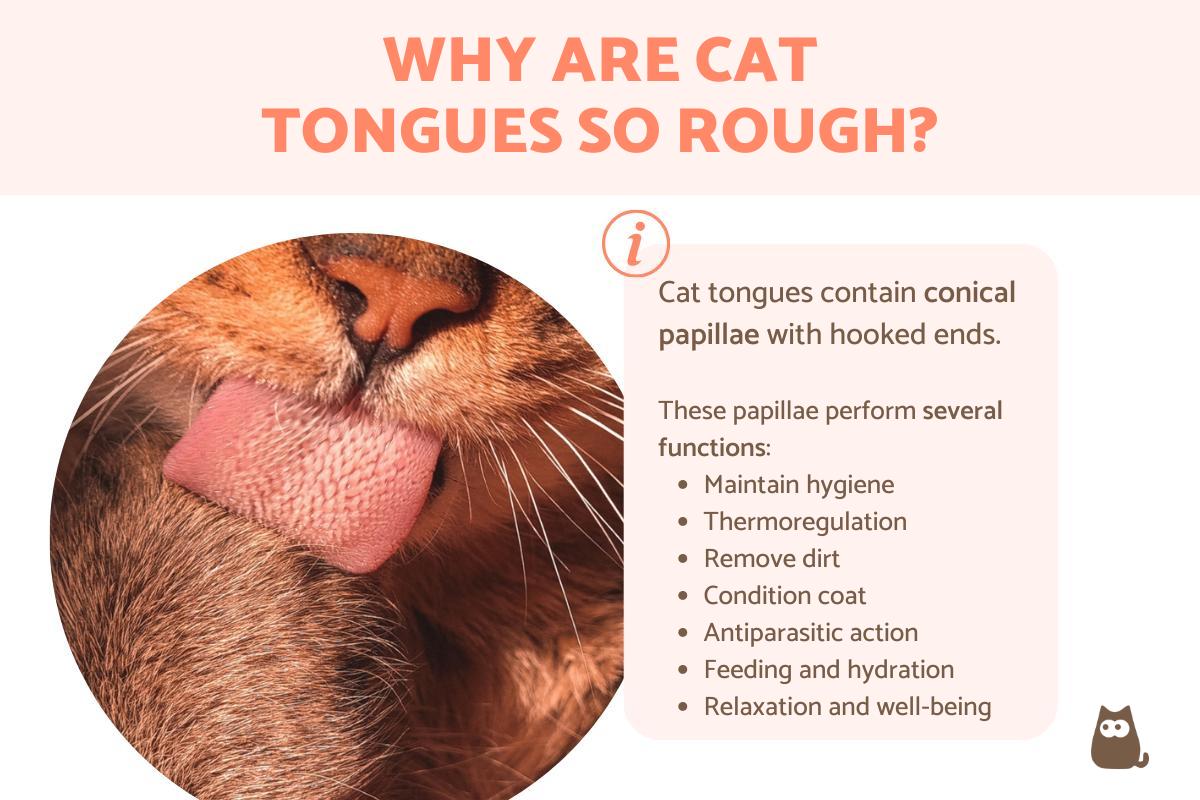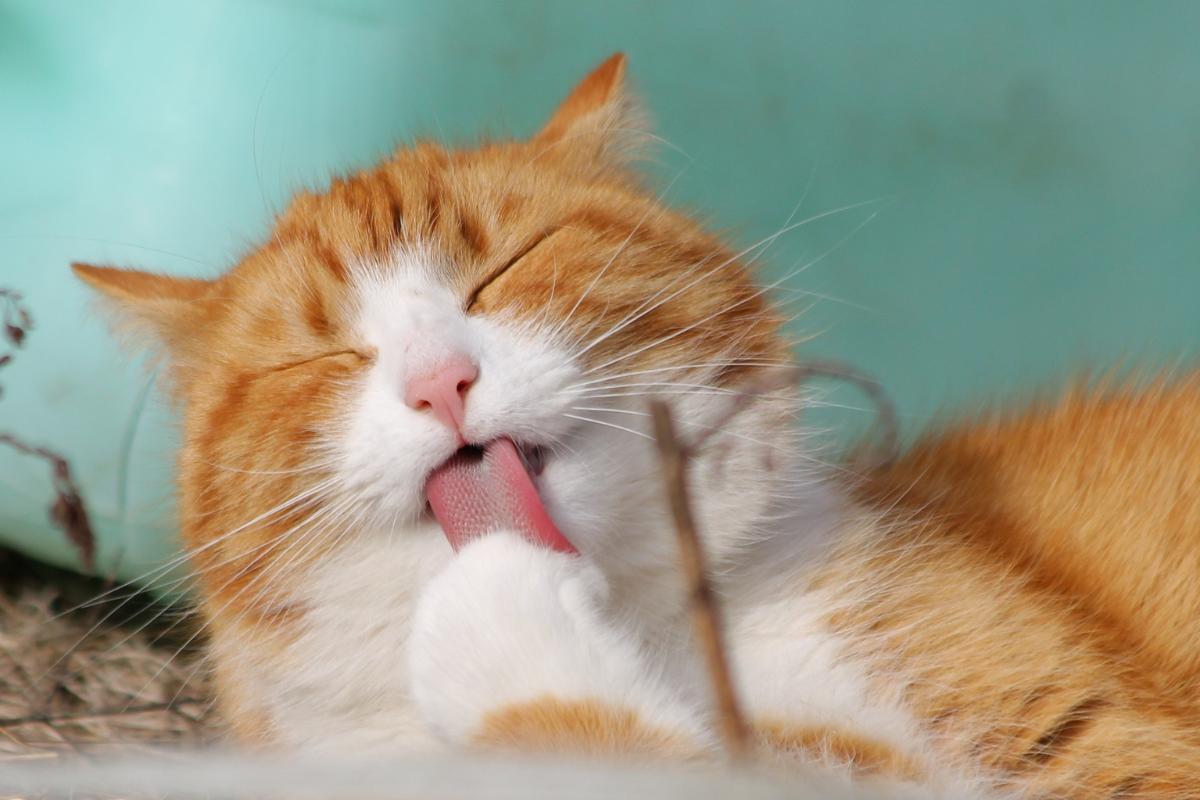Why Do Cats Have Rough Tongues?



See files for Cats
If you look at a cat tongue up close, you will see there are tiny little white hooks covering its surface. Although we expect the tongues of a fellow mammal to be smooth like our own, different animals adapt their body parts for different reasons. A cat's tongue feels rough to the touch. If we are cuddling with a cat, it is common for them to show affection with us by licking. The sensation we feel on our skin can often feel more like sandpaper than what we expect from a tongue. This is thanks to papillae on the tongues surface which serve very important functions for the cat.
At AnimalWised, we learn more about why a cat's tongue feels like sandpaper by asking why do cats have rough tongues? We look more closely at cat tongue anatomy to understand why they have such a unique evolutionary adaptation.
Looking at a cat tongue up close
Feline tongues stand out in the animal kingdom, being the basis of various zoological studies. Cats have structures on their tongues known as papillae. This is not unique, since most mammal species have some type of papillae on their tongue. Humans have them with our own papillae covered in taste buds.
Cat papillae have been studied microscopically. The papillae of a cat's tongue are of different lengths, with the greatest concentration in the center. Each one acts like the tine of a comb. When the cat licks their own coat, these barbed papillae condition the cat's fur so that it maintains health. This is essential for a cat's overall health, with poor coat condition being an indicator of various diseases and illnesses.
When we look at a cat's tongue up close, we see that the papillae are conical in shape and have hooked ends. These hooks not only comb the cat's hair, but they pick up dead hair which is shed. This occurs more at certain times such as during molting season. While this is important for maintaining their coat, it can also influence the formation of hairballs in the gastrointestinal tract, especially in longhaired cat breeds.
Cat tongue papillae are made from a substance known as keratin, the same substance from which mammal hair and nails are made. Recent studies have been able to analyze these papillae even further[1]. These keratinized structures are hollow, providing an empty cavity which can fill with saliva. In this way, the cat is able to wick saliva on their own fur when they are licking themselves.
As we will see further on in this article, this structure is specifically adapted to meet the needs of a feline. While it is particular to a cat, other animals have papillae on their tongues which perform similar functions. We can see this in big cat species such as lions and tigers, but cows, giraffes, anteaters and others also have similar adaptations.
Learn more about why cats have rough tongues with our article on why does my cat lick my hair?

Why are cat tongues so rough?
We have already explained that a cat's tongue is made up of keratin, the same substance from which their claws and hair are made. When a cat claws us with their nails, we can see how sharp and dangerous they can be. Although cat tongue papillae are not as sharp as their claws, they are still rigid structures. Such rigidity is needed to be able to comb their coat and perform other important duties.
If a cat licks our skin, it can feel like sandpaper. It is even possible for them to lick our own hair so much that it pulls out. This is because the combined papillae create friction and a strong force which causes the tongue to feel rough. It can provide an odd sensation, but it is important to know it is completely safe. In fact, if our cat is licking us, it is usually a healthy sign that we share a strong bond together.
Now we know why cats have such rough tongues, you may want to discover why a cat keeps sticking their tongue out in our related article.

Reasons cats have rough tongues
We have explained the physiological and anatomical reasons why a cat's tongue feels like sandpaper, but we have not yet explained all of their functions. Thanks to this evolutionary adaptation, cat tongues are able to play several roles in maintaining feline health and well-being. These include the following:
Grooming
We have already explained that cat tongue papillae act like the tines of a comb. By licking themselves, cats condition their coat the same way we can comb our own hair to maintain its quality. It picks up dead hair and helps to maintain hygiene.
As we have explained, cat tongues also wick saliva onto the coat. This is especially important for the removal of dirt and tangles. Saliva can help to loosen dirt dried on to the cat's hair, making it easier to remove with the kinetic force of their tongue. Similarly, this can help to detangle knots in the fur, something especially common in longhaired cat breeds.
Not all cats are able to detangle their coat through licking alone. Take a look at our guide to getting mats out of a Persian cat's hair to learn how to help.
Disease and parasite protection
Maintaining coat condition is not carried out for aesthetic purposes. Cats do so to maintain their health. Various allergens and pathogens in the environment can collect on a cat's fur, so removing dead hair helps to eliminate them from the cat.
Ectoparasites such as ticks and fleas can also attach themselves to the cat's fur. When a cat feels the bite of one of these parasites, they can lick them off. Since they are external parasites, ingesting them means they will no longer be able to pose a threat. Maintaining hygiene will also help to prevent them attaching themselves in the dirt place.
Feeding and hydration
The conical papillae are also designed to aid in a cat's dietary habits. These hooked papillae can help to separate meat from bone or other undigestible tissues. This is particularly helpful in the wild when they eat live prey. They are also used to lap up water to stay hydrated, Cat taste buds are less developed than in humans, having thousands less in number and being able to register sweet flavors.
Thermoregulation
In addition to helping maintain coat hygiene, wicking saliva onto their coat can help cats to keep warm in winter and cool in summer. In winter, the saliva helps to keep the cat's fur smooth and structured, allowing it to better maintain body heat. In summer, the saliva on their coat evaporates, allowing for cooling in a similar way to sweat in humans. Since cats do not have sweat glands on most of their body, saliva can act in its place. Their rough tongue helps to distribute the saliva for these processes.
Release stress and relaxation
The act of licking releases endorphins that make cats relax and improve their mood. Cats living together will also lick each other to both groom areas they cannot themselves reach, as well as to improve their bond and well-being. When a cat stops grooming, it is a clear sign of apathy which could be due to various physical or emotional health problems. If we see a cat's coat is in poor condition, we need to find out the reason why.
Find out the possible reasons why a cat stops grooming in our article explaining why a cat's fur looks rough.
Hunting
Another function of a cat's tongue is that the curved spikes help to trap prey in their mouth. While this is not necessary for domestic cats being cared for by humans, it is essential for stray, feral or abandoned cats who need to hunt their own prey.
Discover more about the hunting instinct in cats to discover why they are so good at catching prey.

If you want to read similar articles to Why Do Cats Have Rough Tongues?, we recommend you visit our Facts about the animal kingdom category.
1. Noel, A. C., & Hu, D. L. (2018). Cats use hollow papillae to wick saliva into fur. Proceedings of the National Academy of Sciences of the United States of America, 115(49), 12377–12382.
https://doi.org/10.1073/pnas.1809544115







